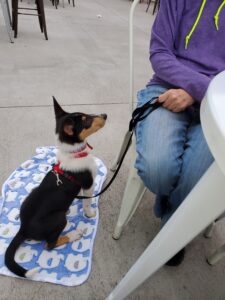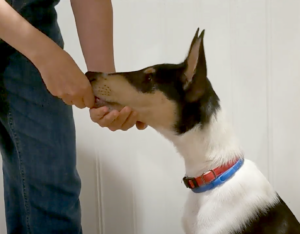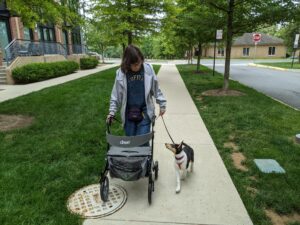People with disabilities training new puppies for service work are always excited about their journey. They look forward to having the help of a fully trained service dog as well as developing a wonderful relationship with their new partner. Owner-trainers’ enthusiasm is a terrific asset in the sometimes-arduous training process, but it can lead to owners putting too much pressure on young pups to perform tasks or to work in public access before they are ready. Service dog trainers can guide owners to pace their puppy’s training experiences appropriately, and to help them understand these key aspects of training a service dog puppy:
1. Service dog candidate puppies need age-appropriate training and socialization.
Analogies can be a helpful tool to facilitate owners’ understanding of the need to pace experiences appropriately for young puppies. Trainers can explain to owners that service dog tasks are like college, and the same way children need to first go to preschool, then elementary school and so forth, it is important for pups to be allowed to have normal developmental experiences and age-appropriate training.
Owners of young prospective service dog candidate pups need education on the same basics that pet owners need: what constitutes appropriate socialization, how to build a solid foundation of basic training, how to implement positive husbandry and care practices, and how to teach good basic manners skills. It also is important for owners to be prepared for fear periods and adolescent behaviors. That way the owner is ready for the ups and downs of behavior as the dog develops, and does not think that “training is not working” when the dog exhibits normal adolescent behavior.
2. Public access preparation needs to be done slowly, and with consideration to the dog’s confidence and stress levels.
While it is not uncommon for pet owners to under-socialize their pups, owner-trainers tend to do the opposite. There is extensive misinformation about socializing a service dog candidate puppy. As a result, it is not uncommon for owner-trainers to treat their young puppies as though they are fully trained public access service dogs and take them to places of public accommodation before the puppy is ready. This results in young dogs not getting enough sleep and down time, and also being overwhelmed and frightened. In short, this can create the very problems owners are trying to prevent.
It is important for service dog trainers to educate owners very specifically about what appropriate socialization should look like. For puppies, this can often occur in pet-friendly locations like hardware stores and parks. It is important for pups to be able to sniff and explore their environment. Early trips need to be short and fun. It helps for trainers to give specifics regarding length of socialization in new places and locations. For example, a 20-minute visit to a coffee shop with outdoor pet-friendly seating.

3. Task training requires that the dog is sufficiently mature and able to focus on longer training sessions.
It takes maturity for dogs to develop the coordination that is needed for precise performance of tasks as well as the long attention span needed to engage in training sessions for complex behavior chains. Introducing task training too early risks the pup learning to dislike training or developing some unwanted behaviors that later have to be addressed through extra training. For instance, trying to teach a retrieve before the pup’s adult teeth are fully in may result in the puppy biting and chewing the item while retrieving. Addressing this issue later can be challenging, and requires additional training that may not have been needed if the owner had waited to introduce a formal retrieve when the dog was older.
Although dogs need to be mature for complex task training, young puppies can be introduced to skills that will form the important foundations for future tasks. For example, a chin rest, nose touch, and front paws on a low platform can be introduced to pups in short, fun training sessions. Trainers can explain to owner-trainers who are impatient to start task training how these foundation behaviors are the building blocks for service dog tasks.

Taking time to train foundation skills to fluency and reliability greatly speeds up task training. I implemented short training sessions on a steady chin rest with my service dog in training, Linus, intermittently when he was between 4 and 7 months old. Then, when he was 9 months old, I started training him to do a formal retrieve and he offered a steady hold in just the second training session. I was able to finish the retrieve in a little over a week and did not encounter issues with him chewing the items at all. This is just one example of how setting a solid foundation allowed for a smooth and quick training process. There is an oft-repeated saying in the service dog world: “Slow is fast.” There is no rushing the service dog training process. Owner-trainers often need to be reminded to enjoy the journey. The first two years of a dog’s life go by very quickly, and the stages of development, even when frustrating, often become wonderful memories. Providing positive, age-appropriate learning experiences is critical for training the dog, and it also teaches the dog that their owner is a trustworthy, safe person. This is as important a foundation to a happy, successful dog-handler relationship as any foundational skill.

